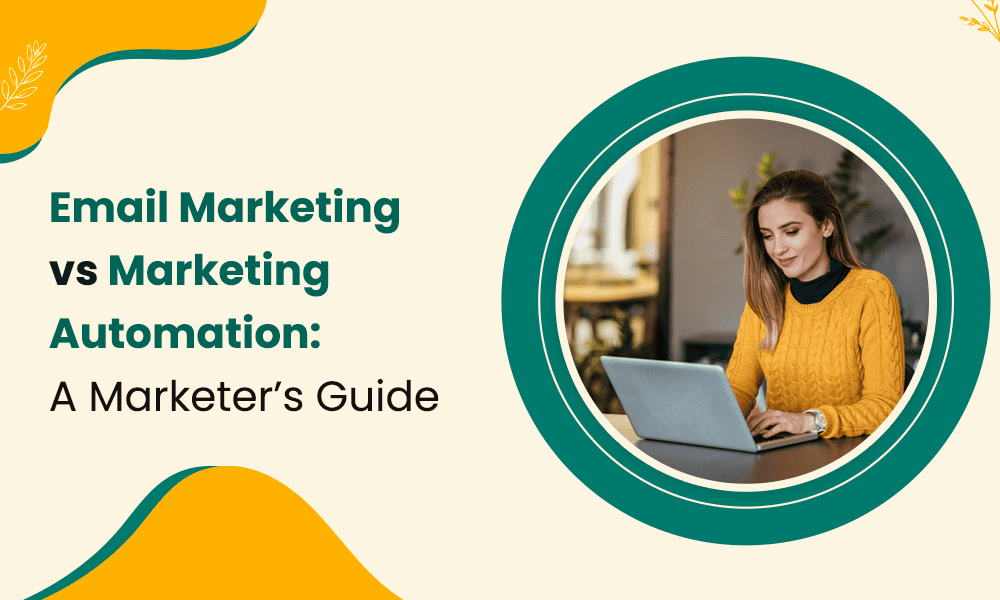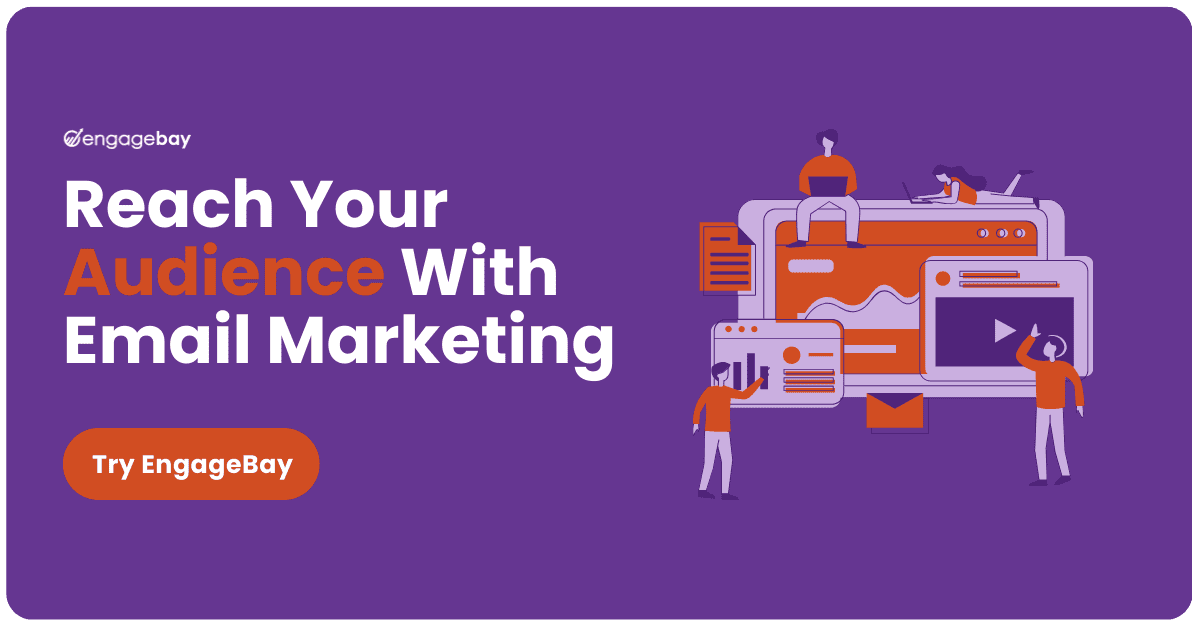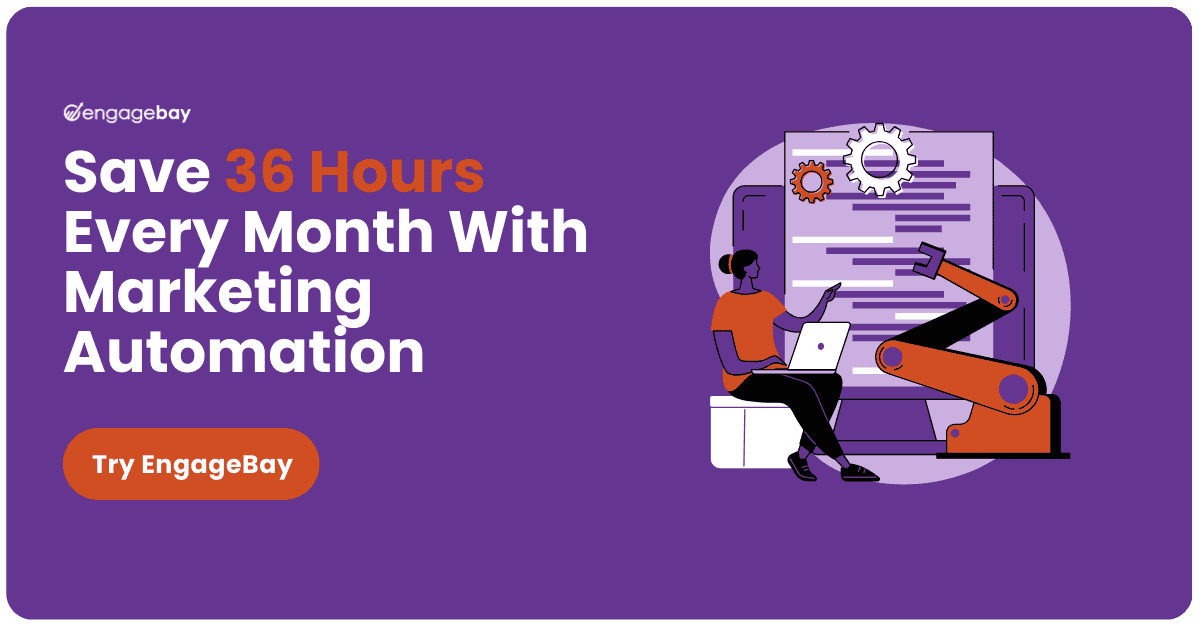You are signed up to an email marketing software that allows you to add subscribers to your email list, filter invalid email addresses, segment your list, and send personalized content at scale to your subscribers and drive sales.
Then, a new marketing need arises.
You want to increase communication touchpoints with your audience, better understand their online behavior for advanced lead scoring, and send ultra-personalized product recommendations across multiple platforms. Thanks to marketing automation, this is possible.
Email marketing and marketing automation are essential pieces in the online marketing puzzle for reaching customers and maximizing sales. Even though they are commonly used interchangeably, their capabilities and function differ. For example, email marketing is primarily an outbound marketing technique, but marketing automation applies to inbound marketing too.
If we are to talk in mathematical terms, which is one of my least favorite things to do (I’m guessing it’s one of your least favorite, too😅), email marketing will be likened to a 180-degree linear communication with email subscribers.
Conversely, with marketing automation, you can achieve 360-degree customer communication and analyze customers’ behavior beyond emails alone.
Now, you may be asking the following questions:
- What is email marketing?
- What is marketing automation?
- How do they differ?
- Can they co-exist?
- How do I integrate both into my eCommerce marketing strategy?
- What factors do I consider when deciding on a marketing automation and email marketing tool?
We’ve got you covered with the answers to these and more. In this blog post, we decode the difference between email marketing and marketing automation and how to use them to meet your marketing objectives.
Let’s begin with the definitions.
Table of Contents
What is Email Marketing?
Email marketing involves sending emails to promote products/services, or build relationships.
Email marketing is an online marketing strategy businesses use to reach potential customers, nurture leads, and communicate directly with them. It is a more traditional approach focusing on building relationships and promoting products or services through email.
Businesses prefer email marketing to other strategies like social media marketing, SEO, and PPC due to its ROI (return on investment), sales conversion, and cost-effectiveness.
👉 Elevate your email marketing with our free email templates designed to boost engagement.
Email marketing vs email marketing automation
Email marketing and email marketing automation are often used interchangeably, but they differ. Email marketing involves direct manual communication with your subscribers or email list.
Conversely, email marketing automation uses tools and software to automate your email marketing strategy for additional benefits such as dynamic content, send time optimization, automated sequence, and increased efficiency.
Automating your email marketing efforts reduces repetition and makes it more efficient.
Imagine sending a welcome email each time a new person subscribes to your email newsletter or a manual ‘thank you’ message each time a subscriber makes a purchase and having to do this for hundreds or thousands of email subscribers (not a pretty imagination at all).
Aside from the errors that could occur and the time consumption that could have been invested in other productive tasks, it’s impossible to scale that way.
That’s why email automation tools like EngageBay take away the hassle of sending emails manually by automating the entire process.
EngageBay provides a visual automation workflow builder that triggers an automated email sequence when a trigger event occurs, such as a new subscriber joining your list. A welcome email is automatically sent so you and your marketing team can spend your time on more productive work.
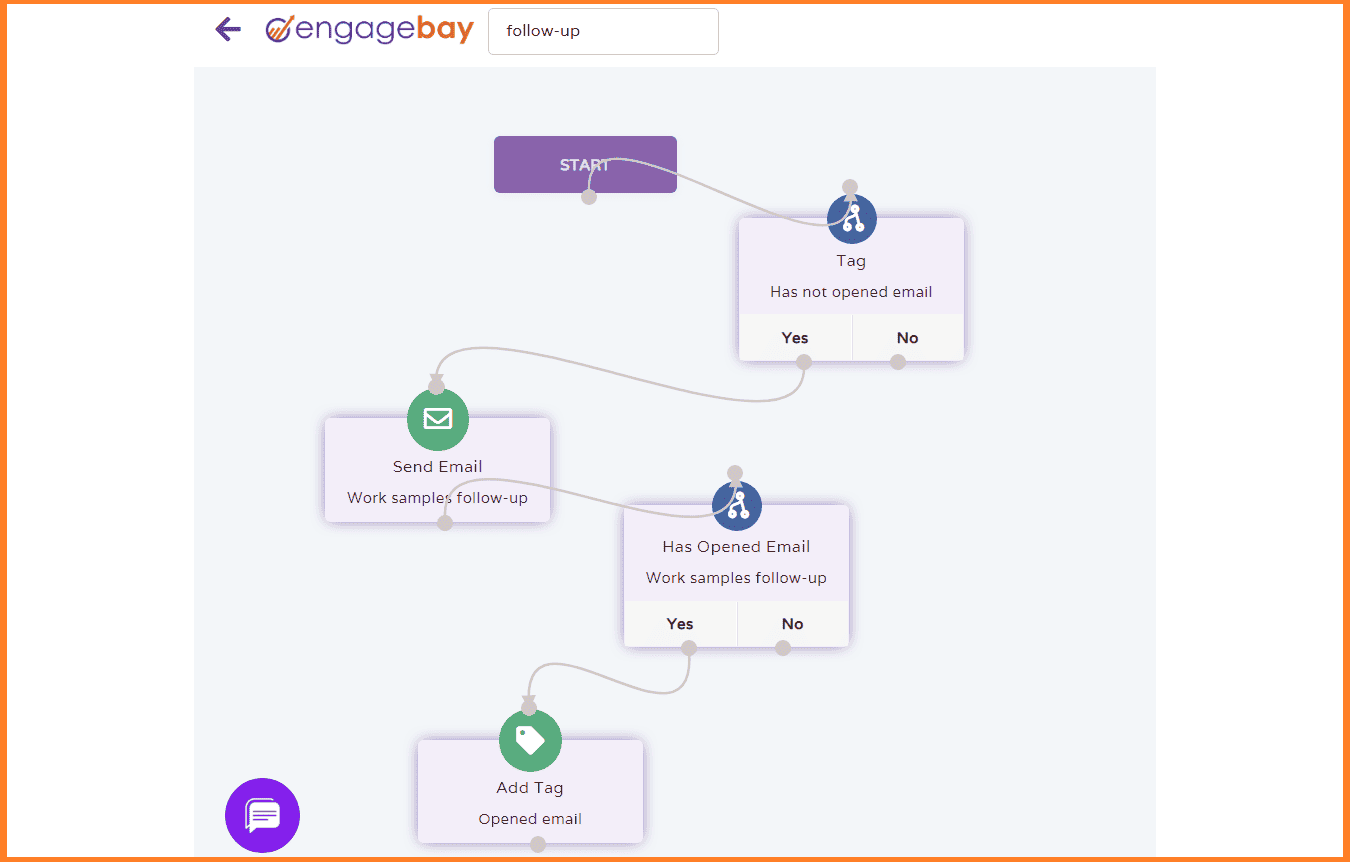
Benefits of Email Marketing
Like every other marketing strategy, email marketing has its benefits, some of which include:
- Direct communication: Emails are sent directly to the recipient’s inbox. No 3rd parties. This direct line of communication makes building customer trust and relationships efficient compared to other marketing strategies that are less direct.
- Return on Investment: Unlike many other marketing strategies like PPC that could sum to $15,000-$20,000 on average for small and mid-sized businesses. Email marketing is highly cost-effective, with an ROI of $36 for every $1 spent. This makes it implementable for businesses of all sizes and marketing budgets.
- Performance analytics: To understand customer preferences and improve your marketing outcomes, you need to measure the performance of your marketing campaigns. With email marketing, you can track your open, bounce, click-through, conversion, and unsubscribe rates to analyze your email conversion funnel and optimize your email campaigns.
- Personalization at scale: Email marketing allows you to tailor messages based on user behavior, preferences, and demographics, making marketing communications more engaging and conversion-oriented. With list segmentation, dynamic content, and lead scoring, you can send personalized emails and product recommendations to subscribers at scale.
Enhance Your Email Marketing
Want to make your emails more impactful? Check out our beautiful, easy-to-customize recruitment and email templates. Designed to boost engagement, these templates from EngageBay will help your emails stand out. Just customize the images, headings, and CTAs for your brand, and hit send in a few minutes!
Examples of Successful Email Marketing Campaigns
Are you curious or need email marketing ideas for your next campaign? Here are three email marketing campaign success stories from which you can garner insight.
1. Dell
Dell, a leading American-based company that develops and manufactures computer products, got creative in their email marketing campaign for a new product launch. The result was a 109% increase in revenue and a 103% increase in conversion rate.
Here’s how it happened.
Before the launch of their new convertible laptop (Dell XPS 12 Convertible Ultrabook), mobile phones were dominating the market to increase the chances of getting their customers’ and email subscribers’ attention; they included a 4 secs GIF that showcased the product features in their email campaign and a subject line that said: “Go from dreaming to doing in a flip.”

This product launch email campaign was a success for several reasons. One, they included a visually appealing GIF that showed users the product’s capabilities in 4 seconds, creating demand and fear of missing out.
They also included a $200 eGift card. Every customer loves getting something for free, making it a win-win situation for Dell and the customers who purchased it.
👉 Enhance your campaigns with our free, customizable email templates that drive results.
2. Airbnb
In 2023 alone, Airbnb generated a 23% profit margin at $8.4 billion in revenue. There are many things Airbnb is doing right to make this happen.
First, they send an email at the end of every year summarising your last trips and trip ideas for the next year. This personalized email pick encourages customers to plan for future trips, making it an effective customer retention strategy.
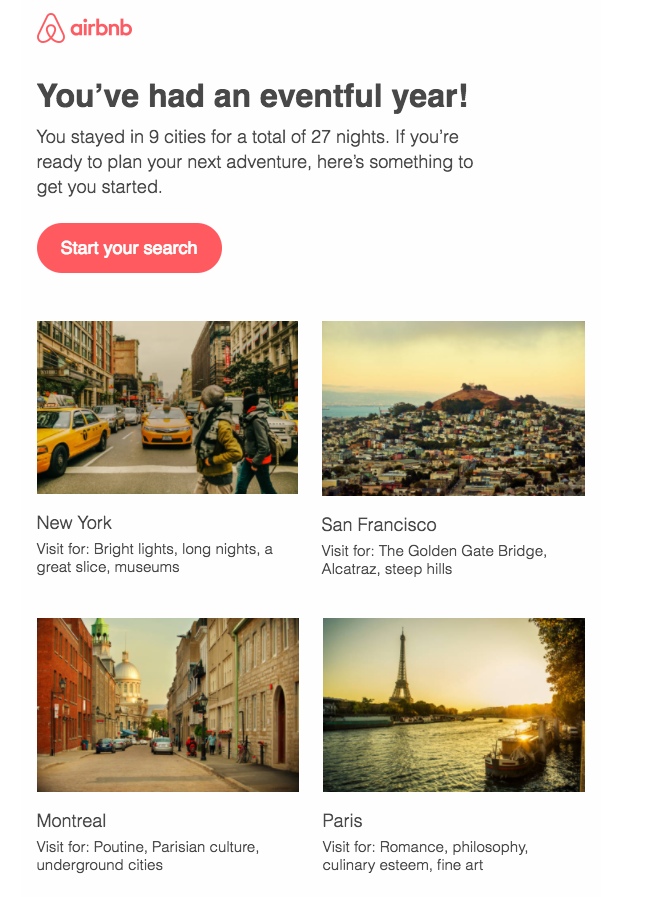
In this successful email campaign example, Airbnb highlights tourist site attractions across different citizens as curated recommendations for their customers to begin planning their next vacation. The use of high-quality images, a summary of past trips, and a small description of where to visit in each recommended city are some of the reasons this email campaign rocks.
3. Netflix
Approximately 1.8 billion people worldwide are subscribed to one or more streaming services. With several streaming service options for customers, Netflix uses its email marketing campaigns to keep users’ interest and attention on them.
In the email example below, the streaming giant provides a list of movies across different categories on Netflix to re-engage its users. The use of its signature colors, red, black, and white, makes it stand out in the recipient inbox.
What Is Marketing Automation?
Marketing automation involves utilizing technology to streamline, automate, and execute marketing strategies.
Marketing automation involves using software to streamline and optimize your marketing processes across multiple channels from a single platform.
When you implement the best practices in marketing automation, you can increase your communication with customers across multiple channels and have the data from all past and present customer interactions due to its ability to integrate seamlessly with a CRM (customer relationship management) tool.
With this, all departments in the company get real-time updates about interactions with customers from the different teams. For instance, if a lead becomes qualified by meeting the criteria set by the marketing team, the sales team will be automatically updated so they can reach out, increasing the chances of closing deals.
There are several tasks you can automate using a marketing automation software tool, including:
- Managing marketing efforts across multiple channels such as email, social media, SMS, and web personalization
- Scheduling and publishing social media posts across your social media platforms
- Assign scores to leads to prioritize them for sales outreach
- Personalizing website content and recommendations based on user behavior
- Capturing and collecting leads through web forms, landing pages, and polls
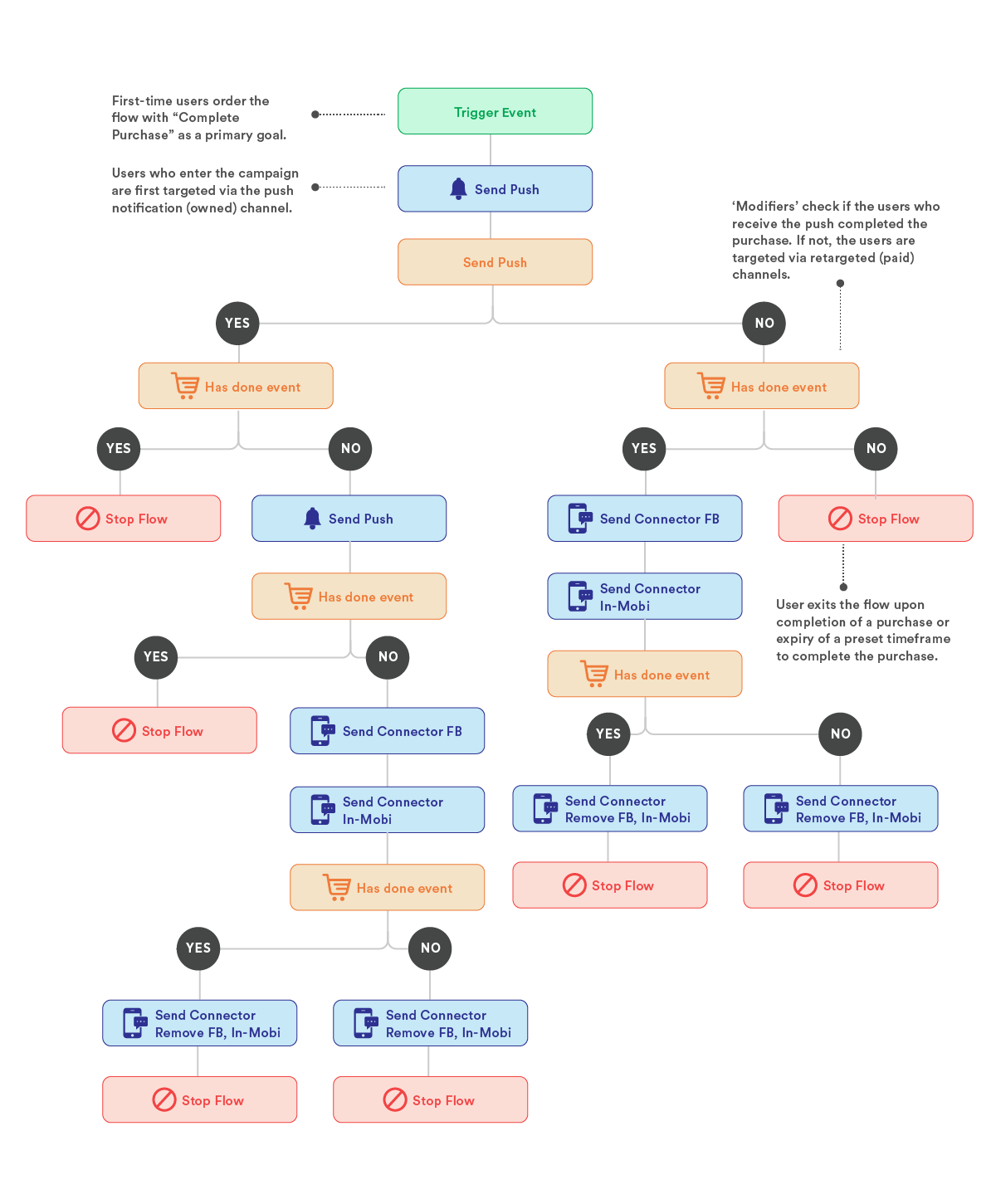
Additionally, according to Ascend2,
- 47% of marketers make use of marketing automation in social media management
- 14% of businesses use marketing automation for their sales funnel communication
- Three out of 10 marketing professionals use marketing automation in their landing pages
- 28% of marketers use marketing automation for their paid ads
- 25% make use of marketing automation for campaign tracking, 17% for lead scoring, and 13% for live chats and push notifications
This further shows the use case of marketing automation beyond emails.
👉 Boost your marketing strategy with our customizable email templates that drive results.
Benefits of Marketing Automation
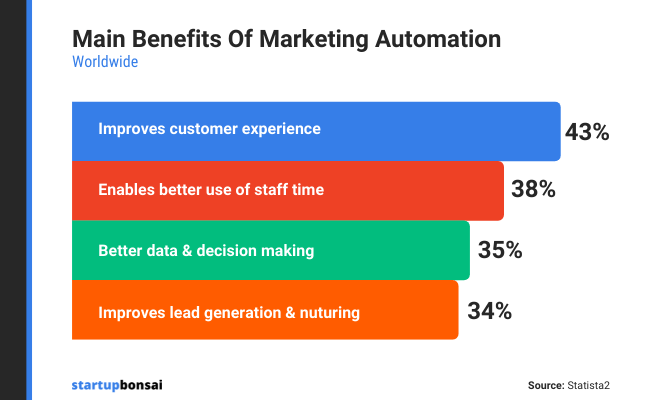
According to Statista, 43% of teams using marketing automation reported better customer experience as the main benefit of marketing automation, followed by better use of time, improved data and decision-making, and improved lead generation and nurturing.
Other benefits are as follows.
1. Advanced lead scoring
With marketing automation’s advanced lead-scoring capabilities, you get better insights into your customers’ preferences beyond what email marketing can give you.
For businesses wanting to prioritize communication based on lead score, marketing automation categorizes leads for effective messaging by assigning values to certain actions based on their perceived importance.
For example, 10 points might be assigned when a new lead visits a pricing page or 15 points when a customer requests a demo.
Leads are then segmented based on scores into different categories for nurturing and personalized messaging. With this, you can prioritize and allocate resources more effectively, focusing on leads with the highest potential for conversion.
2. Multi-channel marketing
This has to be one of the most appreciated advantages of marketing automation.
Marketing automation allows you to manage your marketing efforts, such as scheduling ad campaigns, responding to customer interaction, and ensuring consistent brand messaging across your social media platforms from a single platform.
3. Advanced integration
Marketing automation takes marketing efforts to the next level by allowing integrations to other tools and platforms for more customer reach and increased efficiency.
For instance, you can integrate your eCommerce platforms with marketing automation tools like EngageBay to automate your sales process, track purchases, and send order-related emails. Additionally, marketing automation allows integration with a CRM tool to streamline sales and marketing efforts.
4. Scalability and efficiency
Handling complex marketing campaigns with a marketing automation tool is easy, saving time and reducing human error significantly.
5. Ads retargeting
Retargeting increases conversion rates by up to 150%, making it an effective way to close more sales. Marketing automation makes ad retargeting possible.
Suppose somebody browses your eCommerce website and views a particular product without making a purchase. With ad retargeting, you can target customers with similar product recommendations on other platforms they use, like Google, Facebook, or Instagram, to increase the chances of conversions.
👉 Optimize your marketing efforts with our email templates designed for efficiency and impact.
Email Marketing vs Marketing Automation: What are the Key Differences?
Email marketing and marketing automation are commonly used interchangeably; however, they differ significantly in scope, complexity, goals, and techniques. In the following table, I’ve mentioned how email marketing and marketing automation differ in aspects like scope, complexity, goals, and more.
| Aspect | Email Marketing | Marketing Automation |
| Scope | Email marketing primarily involves direct customer communication through manual or automated email campaigns alone. | Marketing automation involves a broader range of marketing activities and channels. This increases customer communication touchpoints beyond emails alone.
Other marketing automation channels include social media marketing, ads retargeting, multichannel campaign monitoring, and advanced lead scoring. |
| Complexity | It focuses on a single marketing channel (emails), and the sales cycle is usually shorter, which makes it less complicated and easier to implement. Because email marketing is less complicated, it can be implemented by a less advanced team, making it appealing for businesses without robust teams. | Due to the vast capabilities of marketing automation, such as omnichannel marketing and behavioral tracking, it is more complex to implement and manage. It requires a more advanced marketing team. |
| Goals | Email marketing goals are direct and can be easily measured. For instance, your email marketing goal may be to increase sales conversions or to win back inactive subscribers. | Marketing automation goals are more extensive and involve getting a more comprehensive view of customer preferences and journeys from interactions on multiple platforms.
For instance, your goal may be to increase sales through dynamic lead nurturing, so when leads meet predefined criteria, marketing automation triggers a customized action, such as assigning leads to sales teams or entering them into specific nurture campaigns. This type of dynamic nurturing goal is difficult to achieve with email marketing alone. |
| Techniques | Email marketing is primarily an outbound marketing technique because it involves sending promotional content like product updates or recommendations with a key focus on making sales. | Marketing automation uses both inbound and outbound marketing techniques. For example, your social media posts may be reserved for educational content and to organically attract and nurture customers, whereas other marketing channels focus on closing sales. |
👉 Boost your email marketing campaigns with EngageBay’s customizable email templates tailored for engagement and success.
Email Marketing vs Marketing Automation: Any Point of Intersection?
We just spoke about the differences between email marketing and marketing automation. However, marketing automation and email marketing have several similarities. The basic similarity is that both of them are online marketing strategies for attracting and nurturing leads for increased conversion.
Other similarities include the following:
1. High return on investment
A high margin return on investment is critical for business growth and sustainability. Email marketing and marketing automation shine in this area.
Let’s see the figures:
- On average, $5.44 is made for every $1 invested in marketing automation over the first 3 years of implementation.
- Most companies recover the marketing automation investment cost within 6 months. Amazing!
- An average of $36 is made for every $1 spent on email marketing.
2. Email marketing is a marketing automation channel
Email marketing is one of the channels marketing automation incorporates but isn’t limited to the use of emails. They both require sending emails to a list of subscribers.
Marketing automation, however, offers more advanced capabilities beyond emails.
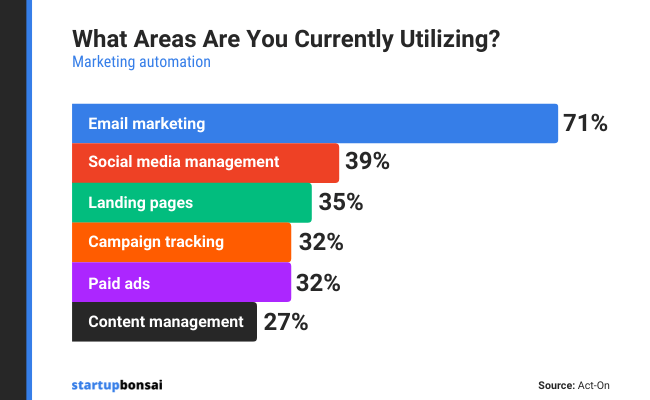
3. Lead generation tools
They are both masterminds in lead generation. When marketing automation and email marketing are combined, you can segment leads and consumers into various groups based on data and nurture them according to their segments.
Segmented email campaigns have 14.3 percent higher open rates and 100.9% greater click-through rates, according to a study by MailChimp.
4. Increased efficiency
Email marketing and marketing automation automate repetitive processes, save time, and lessen the workload on the business staff, giving room for more productivity.
With a marketing automation tool, you can do everything from one software instead of automating emails and other aspects of your digital marketing campaign separately.
Choosing the Right Strategy for Your Business
Having seen the similarities between email marketing and marketing automation and how they complement each other, you know that combining both strategies can change your marketing game and put it on steroids!
Email marketing ensures you maintain direct communication with your email subscribers. Marketing automation ensures you engage with leads and customers across multiple channels at different customer lifecycle stages.
By combining both marketing strategies, you take advantage of the email marketing direct approach while utilizing the strength and intricacy of marketing automation.
For instance, after sending a welcome email to a prospect with email marketing, use marketing automation to get insight into their social media interaction, website visits, and ads they’ve clicked on.
So, you can send personalized product recommendations, increasing your chances of conversion. Below are tools that combine email marketing and marketing automation with their starting price, pros, cons, and ratings.
| Tool | Starting price (billed annually) | Pros | Cons | Rating (Capterra) |
| EngageBay
|
$14.99/month | Responsive customer support, cost-friendly pricing, all-in-one sales, marketing, and support automation | Limited customization | 4.7 |
| ActiveCampaign | $49/month | Split testing, vast online training materials, intuitive interface | No free plans. It gets pricey as contacts increase | 4.6 |
| HubSpot | $800/month | Responsive customer service, advanced automation capabilities such as omnichannel marketing automation | High pricing, steep learning curve, free plan has limited functionality | 4.5 |
| Salesforce Marketing Cloud Account Engagement | $1,250/month | Dynamic campaigns, real-time updates | Requires advanced teams for implementation | 4.1 |
| Klaviyo | $45/month | Robust analytics and customization features | High pricing, slow customer support, steep learning curve | 4.7 |
| Mailchimp | $47/month | Advanced integrations
|
Poor customer support. Additionally, during the first 30 days of their free subscription, customer service is only available via email. | 4.5 |
Factors To Consider When Deciding Between Email Marketing and Marketing Automation
If you still haven’t decided to implement email marketing and marketing automation into your business marketing strategy, you may ask: what is the best choice for my business, email marketing or marketing automation?
The answer to that will depend on several factors.
Email marketing is a better option for you if you’re a small business that requires basic email marketing functions such as:
- Keeping your customers updated with new launches, product listings, or email newsletters
- Sending email sequences to onboard new clients, drip campaigns, or cart abandonment emails to recoup lost sales
- Getting new leads into your email list through sign-up forms on your landing page
However, think of marketing automation if you require more sophisticated marketing options, such as:
- Increasing communication touchpoints with customers on multiple platforms efficiently
- Re-targeting customers who visit your website with marketing offers on other platforms like social media
- Accurately score leads through predictive lead scoring so you can increase your chances of conversion through personalized nurturing
- Have more comprehensive data on customer behavior across multiple platforms
However, marketing needs alone aren’t the only considerations to make when deciding between marketing automation and email marketing; there are other factors to consider before deciding.
1. Team sophistication
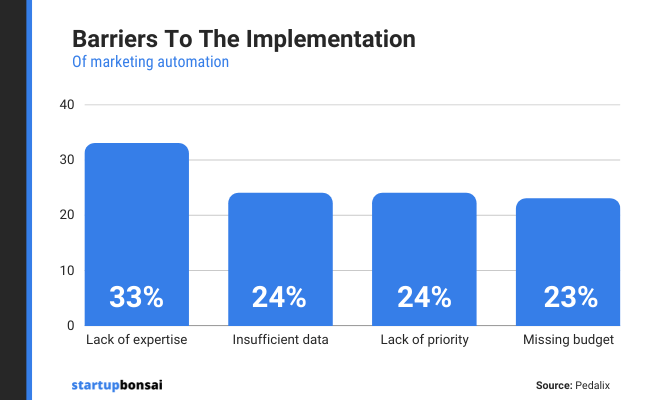
Lack of expertise is a top barrier to implementing marketing automation due to its complexity: only some marketing teams can maximize the functionalities available.
This brings it back to two options: Hire more advanced talents to join your marketing team, which significantly increases your marketing cost, or forfeit maximizing the full capabilities of your marketing automation tool.
That doesn’t have to be the case because automation tools like EngageBay score high on ease of use and have an award-winning customer support team to guide you every step of the way.
However, if your team isn’t advanced enough to handle marketing automation and your marketing needs don’t require advanced marketing automation, it is okay to stick with email marketing.
2. Customer lifecycle
You need to understand your customers’ lifecycle to choose between email marketing and marketing automation. Email marketing may be your best option if your sales cycle is short.
But, suppose your customer sales cycle is long and complex; marketing automation increases your chances of nurturing leads on multiple platforms and providing dynamic content to increase the chances of eventually closing a sale.
3. Scalability
In choosing a marketing strategy, you must choose for the long-term. Choose something that can scale and can be applied even in a much broader context as your business grows.
While it’s good to look at your business’s current needs, consider possible growth in the near future. So, ask the following questions:
- Does this tool meet my current needs?
- Can it accommodate my future marketing needs?
- Does it get more expensive as my marketing needs and contacts increase?
- Can my marketing budget cover the cost as I scale?
4. Advanced reporting
Marketing best practices are a moving train; you constantly need to analyze, refine, and optimize your marketing strategy. To do so, you need data. With email marketing, the data insights you can get are limited. But with marketing automation, you get a 360-degree snapshot of customer behavior and real-time updates, which is beneficial in knowing what works.
For instance, if you’ve implemented omnichannel marketing with marketing automation, you can monitor campaign results all around and know the type of ads or social media platforms that bring the highest conversion.
5. Your budget
Although Marketing automation leads to increased productivity by 14.5% and reduced overhead cost by 12.2%, it costs more to implement than email marketing.
It could range from $800 to $3,600/month billed annually for more expensive marketing automation tools like HubSpot or $11.95 to $73.59/month for more cost-efficient tools like EngageBay.
This cost doesn’t factor in getting more advanced personnel to join your marketing team or additional costs like add-ons.
Pro tip: It may be tricky to decide on marketing automation or email marketing based on your budget alone, but if implementing marketing automation has the potential to increase your business revenue, won’t it be wise to consider increasing your marketing budget to accommodate it rather than putting it off indefinitely?
But hey, this depends on your actual marketing needs.
👉 Enhance your campaigns with our free, customizable email templates that drive results.
Integrating Email Marketing and Marketing Automation
“Business has only two functions – marketing and innovation.” ~ Peter Drucker.
You don’t have to choose between marketing automation or email marketing or use them in silos.
Combined, they can significantly improve your marketing outcomes. As discussed earlier, email marketing is one of the marketing automation channels, and 65% of users implement it in their marketing automation for increased customer interaction and sales.
Here’s a practical example: suppose you use marketing automation to score leads into segments based on their score; you can use email marketing to send them personalized emails to their inbox.
Another example can be if you gain leads through web forms or omnichannel marketing, you can use email sequences to nurture them.
It’s best to integrate email marketing and marketing automation, especially if your marketing needs demand them both.
Wrap Up
We have seen how email marketing and marketing automation intersect and how they differ in complexity, scope, techniques, and goals.
With an understanding of these differences and your marketing budget and business needs, decide on the strategy that works for you: marketing automation, email marketing, or a combination of both.
Suppose you are a small business just starting out and looking to grow. In that case, it is essential to use robust marketing tools like EngageBay that combine email marketing and marketing automation at the cost of one so you can quickly scale to marketing automation when your marketing needs demand it.
For mid-sized business or eCommerce sellers wanting to combine their email, sales, and marketing efforts on a single platform, try EngageBay.
It has the sophistication of HubSpot and advanced features of ActiveCampaign at only a fraction of the cost.
Over to you now, what are your own experiences with email marketing and marketing automation? Which do you think yielded more results for you, and why do you think so?
Kindly share feedback in the comments 😇
👉 Have you tried our email templates? Share your experience in the comments below, and let us know how they worked for your campaigns!
